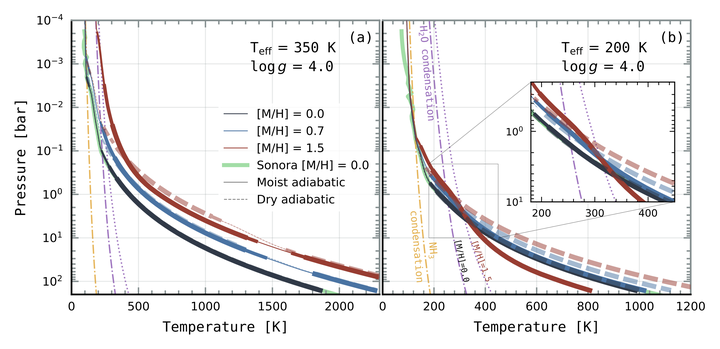Impacts of Water Latent Heat on the Thermal Structure of Ultra-Cool Objects: Brown Dwarfs and Free-Floating Planets
 Image credit: Figure 1 in Tang et al. 2021. Thermal structure profiles from converged solutions of the radiative-convective model at logg = 4.0 for YB ([M/H] of 0.0, here) and YP ([M/H] of 0.7 and 1.5) cases.
Image credit: Figure 1 in Tang et al. 2021. Thermal structure profiles from converged solutions of the radiative-convective model at logg = 4.0 for YB ([M/H] of 0.0, here) and YP ([M/H] of 0.7 and 1.5) cases.
Abstract
Brown dwarfs are essential targets for understanding planetary and sub-stellar atmospheres across a wide range of thermal and chemical conditions. As surveys continue to probe ever deeper, and as observing capabilities continue to improve, the number of known Y dwarfs,—,the coldest class of sub-stellar objects, with effective temperatures below about 600,K,—,is rapidly growing. Critically, this class of ultra-cool objects has atmospheric conditions that overlap with Solar System worlds and, as a result, tools and ideas developed from studying Earth, Jupiter, Saturn and other nearby worlds are well-suited for application to sub-stellar atmospheres. To that end, we developed a one-dimensional (vertical) atmospheric structure model for ultra-cool objects that includes moist adiabatic convection, as this is an important process for many Solar System planets. Application of this model across a range of effective temperatures (350, 300, 250, 200,K), metallicities ([M/H] of 0.0, 0.5, 0.7, 1.5), and gravities (\logg of 4.0, 4.5, 4.7, 5.0) demonstrates strong impacts of water latent heat release on simulated temperature-pressure profiles. At the highest metallicities, water vapor mixing ratios reach an Earth-like 3%, with associated major alterations to the thermal structure in the atmospheric regions where water condenses. Spectroscopic and photometric signatures of metallicity and moist convection should be readily detectable at near- and mid-infrared wavelengths, especially with {\it James Webb Space Telescope} observations, and can help indicate the formation history of an object.